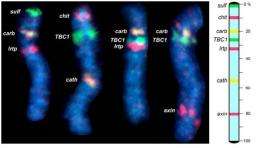BAC-FISH mapping of genes on chromosome 17 in Biston betularia. Image credit: Science/DOI:10.1126/science.1203043
During the Industrial Revolution in 19th-century England, black moths started appearing - because they blended in better on pollution-darkened tree trunks than did normal, speckled moths. Now scientists are closing in on the genetic change responsible for that classic example of natural selection.
The peppered moth is a black-and-white-spattered moth that clings to trees in the daytime. In 1800s England, dark soot from the factories began to coat trees once covered with pale lichen. That was when the black-bodied version began showing up in the population - and some 1950s experiments showed why: In polluted areas, birds devoured the light, speckled moths in greater numbers than the black ones, because they were easier to see. (In clean areas, the opposite held true: Birds ate more of the dark moths.)
Ilik Saccheri, an evolutionary biologist at the University of Liverpool, and colleagues decided to use modern molecular tools to figure out what DNA changes caused the shift.
To do so, the researchers conducted extensive moth breeding and scoured the insects' genomes for little genetic variations that always showed up when the bodies were black. They traced the mutation to a DNA region in a particular place on one of the moth chromosomes, which implied that the gene causing the black color must lie in that region.
The scientists were also interested in knowing whether black moths had arisen many times independently during the period of pollution. To study that, they sampled black moths found in 80 different locations in the United Kingdom. In all cases, they found the same DNA fingerprint - suggesting that the mutation for black coloration came from one original moth.
The scientists still don't know precisely what gene caused the blackness, however - Saccheri said that would take further study.
"This is only the beginning, really," he said.
The team also noted that the chromosome region in which the gene lies is known, in many species of butterflies, to influence the patterns on wings. This chromosome segment may have been of great importance in driving shape and color changes during moth and butterfly evolution, said Robert Reed, a University of California, Irvine, evolutionary geneticist who was not involved in the study.
The study was published in the journal Science.
More information: Industrial Melanism in British Peppered Moths Has a Singular and Recent Mutational Origin, Science, DOI:10.1126/science.1203043
(c) 2011, Los Angeles Times.
Distributed by McClatchy-Tribune Information Services.





















